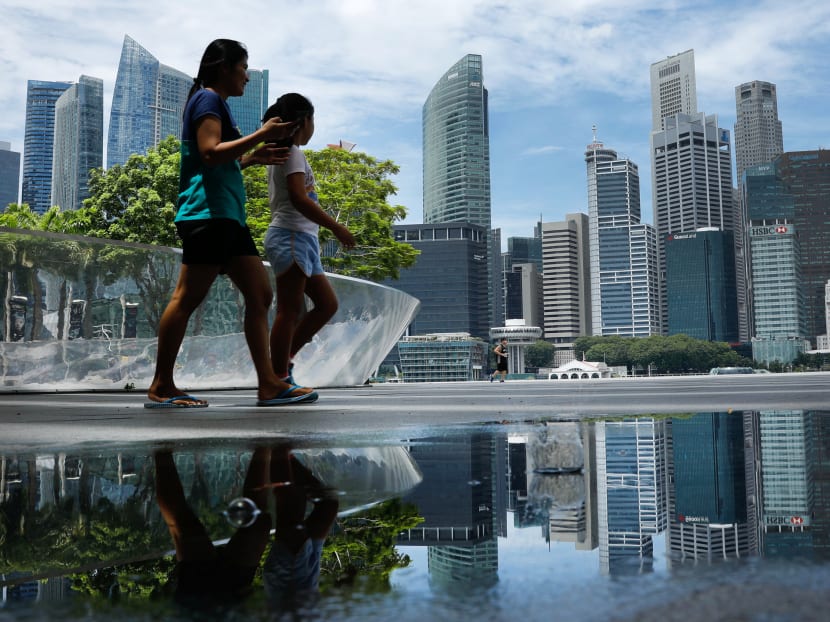Tightening of monetary policy in sight for next review, say economists
SINGAPORE — Some private sector economists expect that the central bank could allow the Singapore dollar to appreciate by the next review in April next year, after standing pat since April 2016.

Some private sector economists forecast a slight increase in the Singapore dollar Nominal Effective Exchange Rate (S$NEER), citing the better-than-expected economic growth of 4.6 per cent in the third quarter, which would lead to a better full-year growth. Photo: Reuters
SINGAPORE — Some private sector economists expect that the central bank could allow the Singapore dollar to appreciate by the next review in April next year, after standing pat since April 2016.
They forecast a slight increase in the Singapore dollar Nominal Effective Exchange Rate (S$NEER), citing the better-than-expected economic growth of 4.6 per cent in the third quarter, which would lead to a better full-year growth.
Some also added that the neutral stance has been at play for an extended period — the last time the neutral policy stance has been held for 18 months was during the 2008/09 Financial Crisis.
The Monetary Authority of Singapore (MAS), in line with expectations, maintained its current neutral appreciation stance for the S$NEER on Friday (Oct 13). But its policy statement did not keep with the view that the current monetary policy was to be kept for an “extended period of time”, unlike in the previous two rounds of review.
“We take this to mean that the MAS will be assessing more carefully the potential normalisation of Singapore’s monetary policy from the next policy meeting (April 2018) onwards, possibly embarking on a 0.5 per cent pa slope in the next meeting,” UOB economist Francis Tan said.
Maybank Kim Eng economist Chua Hak Bin, who had expected a change in this round of review, given the strong upswing in GDP expected, expects a “slight appreciation bias” for the S$NEER in April.
“The S$NEER is currently trading at about 0.9 per cent above the mid-point, by our estimates. We think that the S$NEER may test the upper bound of the band during the interim period in the run-up to the April 2018 meeting, given the current trajectory. Strong exports and trade numbers will likely continue supporting the Singapore dollar,” he added.
The MAS has two scheduled policy announcements a year, in April and October. The S$NEER, which tracks the Singapore dollar against an undisclosed basket of currencies from the Republic’s major trading partners and competitors, is the MAS’ main policy tool, weighing inflation from overseas and economic growth.
The central bank intervenes by keeping the exchange rate within an unspecified band and changes the slope, width and level at which it is centred when it wants to adjust the pace of appreciation or depreciation of the local currency. A stronger currency keeps inflation in check because imports become cheaper, while a weaker currency makes exports more attractive, lifting growth.
Amid slow growth and low inflation, a neutral policy stance of zero appreciation against the Republic’s major trading partners has been in place since April last year.
The MAS’ latest policy statement on Friday struck a slightly more upbeat tone despite saying it was not changing its policy stance, noting that Singapore economy has performed “slightly better than envisaged” since the April 2017 policy review.
Some economists were unsurprised that the MAS has not changed its monetary policy yet, noting that growth was still uneven.
“Some places are seeing growth, whilst some others are not,” said Mr Tan, adding that oil inventory was still capping inflation while the labour market continued to be weak.
“The still weak labour market will cap any form of wage cost pass-through to consumer inflation, while the stronger Singapore dollar had limited imported inflation. These factors allow for the continuation of the neutral S$NEER policy,” he added.
On Friday, the central bank said MAS Core Inflation is projected to come in at around 1.5 per cent in 2017 and average 1–2 per cent next year. Headline inflation is expected to come in at around 0.5 per cent this year, and stay in the range of 0–1 per cent in 2018.
Looking ahead, MAS said: “The Singapore economy is likely to expand at a steady, but slightly slower, pace in 2018 compared to 2017.”





